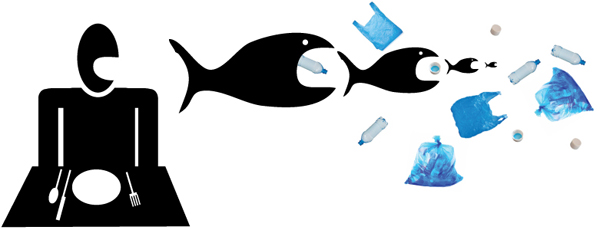you are eating plastic particles every day?
🌊🦈Did you know that you are eating plastic particles every day??🦈♻️
(by, Cherika Ranasinghe)

Much recent attention focused on how these tiny pieces, microplastics are filling the seas & working their way into the creatures that living in them. Microplastics are ranging from 5 millimetres down to 100 nanometres in diameter. Did you know that these tiny particles are entering the food chain through marine creatures & ultimately to our bodies.
When we consider about sources from the sea, it's harder to know how many microplastics we might be consuming from fish. Most studies have only analysed the stomach & gut content of microplastics of the organisms we consume. But, that may not be a problem as those parts are usually removed prior to consumption. But, studies have found microplastics in some fish livers. Researchers have suggested that microplastic particles can passed from digestive tissues to rest of body parts.
It has been found that canned fish also contain microplastics. Hopefully, the numbers identified were very low. Therefore, the average consumer might only eat up to 5 microplastic particles from a portion in this way. These particles might also come from the atmospheric air. Another kind of marine food source containing microplastic is sea salt. One kilogram of salt can contain over 600 microplastics. The human health effects are still unknown. But, there is mounting evidence that they are harming sea animal lives.
The key source of microplastics in the ongoing fragmentation and that larger pieces such as bottles and plastic packaging gradually break down into smaller and smaller pieces as a result of exposure to ultraviolet radiation, oxygen, and friction. They can enter the ocean as primary microplastics such as beads from personal care products, microfibres from clothes & pre-production pellets. Also, the secondary microplastics which are derived from larger plastic items that slowly get broken into smaller pieces.
There might be as many as 50 trillion particles of microplastic in the world's oceans. The problem is that they don't disappear in the environment & the problem could be even worse than we think because microplastics are very difficult to find & measure. So we should encourage people to take measures such as banning the use of microplastics in cosmetics & so on.
ඔබ දිනපතා ප්ලාස්ටික් අංශු අනුභව කරන බව ඔබ දැන සිටියාද?

මෙම කුඩා ප්ලාස්ටික් කැබලි මුහුද පවතින්නේ කෙසේද සහ ඒවා මුහුද තුළ ජීවත්වන ජීවීන් තුළට ගමන් කරන්නේ කෙසේද යන්න පිළිබඳව විශාල අවධානයක් යොමු කල යුතුය.
මයික්රොප්ලාස්ටික්, විෂ්කම්භය මිලිමීටර 5 සිට නැනෝමීටර් 100 දක්වා පරාසයක පවතී. මෙම කුඩා අංශු සමුද්ර ජීවීන් හරහා ආහාර දාමයට ඇතුළු වී අවසානයේ අප තුල ශරීරගත බව ඔබ දැන සිටියාද?
මුහුද තුල ප්රභවයන් ගැන සලකා බලන විට, මාළු වලින් අප මෙම මයික්රොප්ලාස්ටික් කොපමණ ප්රමාණයක් පරිභෝජනය කරතැය දැන ගැනීම දුෂ්කර ය. බොහෝ අධ්යයනයන් මගින් විශ්ලේෂණය කර ඇත්තේ අප පරිභෝජනය කරන ජීවීන්ගේ ආමාශය සහ බඩවැල් තුල මයික්රොප්ලාස්ටික් අන්තර්ගතය පමණි. නමුත්, එම කොටස් සාමාන්යයෙන් පරිභෝජනයට පෙර ඉවත් කරන බැවින් එය ගැටළුවක් නොවනු ඇත. එහෙත්, සමහර අධ්යයනයන් මගින්, මාළු අක්මාව තුළ මෙම ප්ලාස්ටික් අංශු සොයාගෙන ඇත. පර්යේෂකයන් යෝජනා කර ඇත්තේ ආහාර ජීර්ණ පටක වල සිට ශරීරයේ සෙසු කොටස් දක්වා මයික්රොප්ලාස්ටික් අංශු ගමන් කළ හැකි බවයි.
ටින් මාළු වලද මයික්රොප්ලාස්ටික් අඩංගු බව සොයාගෙන ඇත. නමුත්, දැනට හඳුනාගත් සංඛ්යා ඉතා අඩු ප්රමාණයකි. එමනිසා, සාමාන්යයෙන් පාරිභෝගිකයෙකු ආහාරයට ගනු ඇත්තේ මේ ආකාරයේ කොටසකින් මයික්රොප්ලාස්ටික් අංශු 5 ක් පමණි. මෙම අංශු වායුගෝලීය වාතයෙන් ද පැමිණිය හැකිය. මයික්රොප්ලාස්ටික් අඩංගු තවත් සාගර ආහාර ප්රභවයක් වන්නේ මුහුදු ලුණු ය. එක් ලුණු කිලෝග්රෑමයක මයික්රොප්ලාස්ටික් 600 කට වඩා අඩංගු විය හැකිය.
මෙමගින් මිනිස් සෞඛ්යමය බලපෑම් පිලිබඳ හරිහැටි මිනුමක් තවමත් නොදනී. එහෙත්, මේවා මුහුදු ජීව විශේෂ වලට හානි කරන බවට විවිධ සාක්ෂි තිබේ.
ක්ෂුද්ර ප්ලාස්ටික් වල ප්රධාන ප්රභවය වන්නේ අඛණ්ඩ ඛණ්ඩනය වීම සහ පාරජම්බුල විකිරණ, ඔක්සිජන් හා ඝර්ෂණයට නිරාවරණය වීමේ ප්රතිඵලයක් ලෙස බෝතල් හා ප්ලාස්ටික් ඇසුරුම් වැනි විශාල කැබලි ක්රමයෙන් කුඩා හා කුඩා කැබලිවලට කැඩී යාමයි. පුද්ගලික සත්කාරක නිෂ්පාදන වලින් පබළු, ඇඳුම් වලින් මයික්රෝ ෆයිබර් සහ පූර්ව නිෂ්පාදන පෙති වැනි ආකාර ප්රාථමික ක්ෂුද්ර ප්ලාස්ටික් ලෙස සාගරයට ඇතුළු විය හැකිය. එමෙන්ම, ද්විතියික ක්ෂුද්ර ප්ලාස්ටික් ලෙස විශාල ප්ලාස්ටික් අයිතම කුඩා කොටස් වලට සෙමෙන් කැඩී යන කොටස් ඇතුලත් වේ.
ලෝක සාගර තුල ක්ෂුද්ර ප්ලාස්ටික් අංශු ට්රිලියන 50 ක් පමණ තිබිය හැකිය. ගැටළුව වන්නේ ඒවා පරිසරයෙන් අතුරුදහන් නොවීමයි. ගැටලුව අප සිතනවාටත් වඩා දරුණු විය හැකිය, මන්ද, මයික්රොපලාස්ටික් සොයා ගැනීම සහ ප්රමාණයක් මැනීම ඉතා අපහසු බැවිනි. එබැවින් රූපලාවණ්ය සඳහා ක්ෂුද්ර ප්ලාස්ටික් භාවිතය තහනම් කිරීම වැනි ක්රියාමාර්ග ගැනීමට අප ජනතාව දිරිමත් කළ යුතුය.
References: - https://theconversation.com/youre-eating-microplastics-in-ways-you-dont-even-realise-97649
Photos by: - https://www.sustainability-times.com/wp-content/uploads/2019/08/dims.jpg
https://images.newscientist.com/wp-content/uploads/2019/08/15153635/gettyimages-1036767280.jpg
https://www.sciencenewsforstudents.org/wp-content/uploads/2020/01/1030_microplastics-1028x579.png
https://back.3blmedia.com/sites/default/files/styles/ratio_3_2/public/triplepundit/wide/plastics.jpeg
https://www.sciencelearn.org.nz/resources/2809-how-harmful-are-microplastics
https://www.intechopen.com/books/toxicology-new-aspects-to-this-scientific-conundrum/microplastics-in-aquatic-environments-and-their-toxicological-implications-for-fish
https://www.sciencealert.com/a-widely-reported-study-on-the-effects-of-microplastics-in-fish-is-about-to-be-retracted
#incredibleoceans #ocuknowledgehub #marinescience #microplastics🦈🌊♻️
උපුටා ගැනීමක්





No comments
You are WELL COME👏👏😘